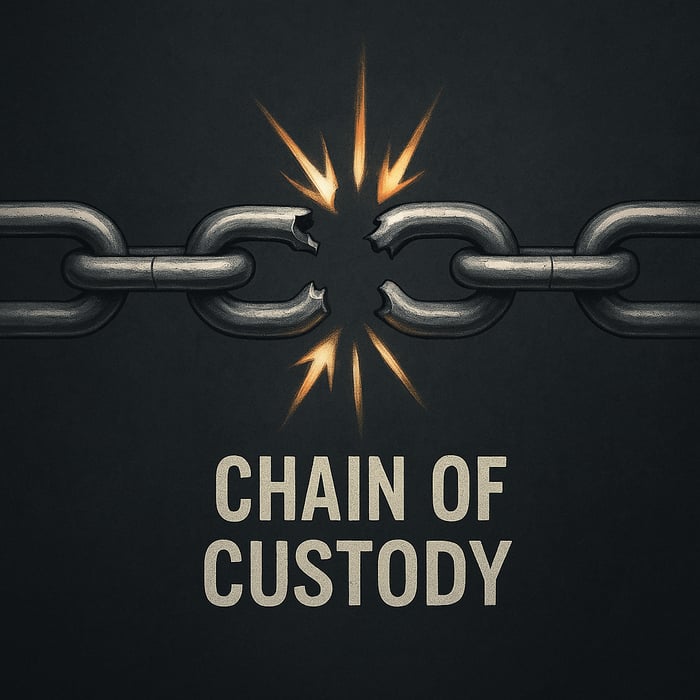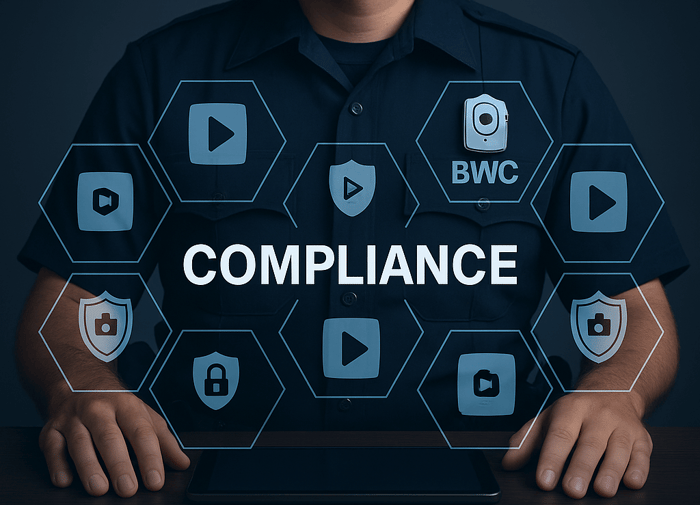Table of Contents
The Importance of Maintaining an Unbroken Chain of Custody
In law enforcement and legal proceedings, video evidence is only as credible as the process used to handle it. A chain of custody refers to the chronological documentation of how evidence is collected, stored, transferred, and processed from the moment of acquisition until it’s presented in court. This record is "a critical, procedural safeguard" that ensures digital evidence remains uncontaminated and unchanged throughout its lifecycle. In practice, this means proving that it’s highly improbable any tampering or substitution occurred with the footage. If the chain of custody is broken at any point – for example, if there's unexplained access or edits – the evidence’s integrity can be called into question, potentially rendering the video inadmissible in court.
For video evidence, maintaining a clear chain of custody is especially vital. Unlike physical evidence that can be sealed in bags, digital videos can be copied or altered if not handled carefully. Courts and defense attorneys will scrutinize whether a video clip has “not been altered in any way” from its original form. Proper chain-of-custody procedures give prosecutors confidence to assert a video’s authenticity and help preempt any argument that the footage was doctored. In high-profile cases (e.g. the O.J. Simpson trial), weak custody tracking allowed defense teams to create reasonable doubt about evidence handling. In short, an unbroken chain of custody establishes trust in the evidence, which is paramount for video since it often plays a pivotal role in modern trials.
Challenges of Video Redaction and Evidence Integrity
Video redaction – the process of obscuring or removing sensitive details (faces, license plates, audio, etc.) – introduces additional challenges to the chain of custody. On one hand, redaction is often legally necessary to protect privacy or comply with laws (for instance, to blur juveniles’ faces or mute confidential info). On the other hand, redacting a video means editing the original footage, which must be done in a way that preserves the evidence’s authenticity. Improper handling during redaction could raise questions about whether content was improperly altered or if the “edited” footage still reflects the truth of the incident.
To ensure the redacted video remains legally admissible, agencies need rigorous procedures so that only the intended redactions occur and nothing else is changed. This requires thorough documentation and tracking of every step in the redaction process. For example, it’s best practice to keep the original file intact and perform redactions on a forensic copy of the video, so the original can always be produced to verify the changes. Every action – from creating a copy, to applying blurs, to exporting the final redacted clip – should be logged with timestamped records of who did what. In fact, modern evidence management systems and redaction software often facilitate this by generating audit logs and cryptographic hashes. A Secure Hash Algorithm (SHA) hash of the original file can be compared with a hash of the redacted file to confirm that no unauthorized alterations occurred during redaction. By addressing these challenges with proper controls, the redacted video can be shown to be reliable – containing all the same evidentiary content as the original, minus the obscured details – and thus admissible.
Another challenge arises when agencies leverage third-party services for video redaction. Outsourcing can greatly improve efficiency and accuracy, but it requires trusting an outside provider with sensitive evidence. It’s essential to vet external redaction services to ensure they follow strict security and confidentiality protocols. When using a service like Focal Forensics – one of the leading video redaction providers – agencies should look for commitments to maintaining chain of custody, such as encrypted file transfers and CJIS-compliant handling of evidence. Focal Forensics, for example, employs a secure, encrypted platform for transferring video files and adheres to the FBI’s Criminal Justice Information Services (CJIS) Security Policy to safeguard evidence. These measures mitigate the risk of any break in custody when footage is handled outside the agency. By addressing the unique chain-of-custody issues posed by video redaction, law enforcement and legal teams can confidently use edited footage without fear of it being tossed out on a technicality.
Step-by-Step Chain of Custody Checklist for Video Redaction
To maintain a clear chain of custody during the video redaction process, follow this step-by-step checklist. Each step focuses on documentation, security, and transparency so that any edited footage remains legally admissible:
Collect and Secure the Original Video: As soon as video evidence is obtained (from a body-worn camera, CCTV system, cell phone, etc.), secure the original recording. Document the date, time, and location of collection, and who collected it, in an evidence log or chain-of-custody form. Label the media or file with a unique identifier. Store the original video in a secure evidence storage system with restricted access (e.g. a digital evidence management system with access controls). This initial documentation creates the first link in the custody chain.
Preserve the Original Unaltered (Use Forensic Copy for Work): Never redact or alter the original footage directly. Instead, make a forensic copy of the original video for redaction purposes. Use specialized software or hardware to clone the file bit-for-bit. Immediately generate a cryptographic hash (e.g. SHA-256) of the original file and record this value in your documentation. This hash will serve as a digital fingerprint to prove the original was not modified. Keep the original file sealed (digitally or physically) so it remains pristine; all editing will be done on the copy. By preserving an unaltered original, you can always demonstrate what the footage looked like pre-redaction, assuring the court that only approved edits (blurring, redacting) were made to the evidence.
Track Every Transfer or Access: Each time the video evidence (original or copy) changes hands or is moved, update the chain-of-custody log. Record who accessed or received the video, when, and for what purpose. For digital video files, this might include logging when the file is uploaded to a server, when it’s downloaded or copied, and who authorized those actions. If the video is sent to an external redaction specialist or a lab, use secure transfer methods (never unsecured email or consumer file-sharing links). Ideally, use an encrypted file transfer platform to prevent interception. By carefully logging transfers and access, you maintain a chronological paper trail that shows an unbroken custody chain from collection through editing.
Use Authorized Personnel and Tools for Redaction: Conduct the redaction on the copied video using trusted tools and trained personnel. Limit this task to authorized individuals – for instance, a forensic video analyst or a vetted third-party service – and ensure they know and follow chain-of-custody protocols. If using a third-party provider like Focal Forensics, confirm they meet high security standards (e.g. CJIS compliance, background-checked staff). They should utilize secure redaction software and maintain evidence integrity throughout the process. Make sure that any external redaction service formally signs on/off the evidence transfer, so it’s clear when custody passes to them and back to your agency. Maintaining strict control over who can handle the video and how they do it prevents unauthorized edits and supports the credibility of the redacted evidence.
Document the Redaction Process in Detail: Treat the act of redaction as a critical event in the evidence timeline. Log every action taken during redaction – including the date/time editing began and ended, the software used, and a summary of what was redacted (for example, “blurred all civilian faces and muted 911 caller’s name at 02:13 timestamp”). Include who performed the redaction (name and role) and who supervised or reviewed it. Modern redaction software can assist by automatically generating a redaction log or report. In fact, best-in-class tools will create a detailed activity log of the redaction steps, which can be exported and added to your chain-of-custody documentation. Focal Forensics’ own automated redaction system, for instance, provides a clear redaction log recording who redacted what and when, helping maintain a thorough chain of custody. Capturing these details ensures that if anyone questions the editing, you can show exactly what was done and that no substantive content was tampered with beyond the necessary privacy edits.
Maintain an Audit Trail and Version Control: As you produce the redacted video file, treat it as a new piece of evidence linked to the original. Save the redacted version with a distinct file name or ID, and record its creation in the evidence log (including time and responsible person). Compute a hash of the redacted file as well, and note it alongside the original hash in your records. The difference between the original and redacted hash is expected (since content was blurred or removed), but having both values demonstrates that the files are fixed and identifiable. If using a digital evidence management system (DEMS), upload the redacted video into the system so that it tracks who views or downloads it going forward. Ensure that no one can alter or delete the original or redacted files without leaving an audit trace. Version control is crucial – if further edits or additional redactions are needed, each new version should be saved separately and logged, rather than overwriting previous versions. This way, you can always produce all versions of the video and show the progression of edits, which protects against accusations of evidence manipulation.
Securely Store Both Original and Redacted Footage: After redaction, both the original and redacted videos should be stored in a secure manner. The original, having never been altered, might remain in the agency’s evidence locker or secure server with limited access (read-only to most users). The redacted version, which is likely the one to be used in court or released, should likewise be stored securely – ideally in the same evidence system – and clearly labeled as the “Redacted Copy” of a specific original item. Use tamper-evident seals or digital access controls to ensure no further changes occur without authorization. Only personnel with a need (prosecutors, investigators, or authorized legal parties) should be allowed to access the footage, and every access should continue to be logged. By safeguarding the files in a controlled environment, you extend the chain of custody through the post-redaction phase up until presentation in court.
Provide Complete Documentation for Admissibility: When it comes time to use the redacted video in a legal proceeding, be prepared with a complete chain-of-custody packet. This should include the initial collection records, transfer logs, hash values, redaction logs, and storage records – essentially, all documentation from steps 1–7 compiled in an easily understandable format. The goal is to be able to demonstrate to a judge (or satisfy a defense challenge) that the footage is authentic and traceable at every step. If needed, an expert (e.g. the forensic video technician or a Focal Forensics representative) can testify how the redaction was done without affecting the evidentiary value of the video. With proper documentation in hand, you can show the court that the video was handled meticulously and that the redacted version is a true and accurate representation of the original evidence, aside from the court-approved obscurations. This thorough documentation and tracking ensures the edited footage remains legally admissible, having preserved the chain of custody from start to finish.
Conclusion
Maintaining a clear chain of custody for video evidence – especially through the redaction process – is essential for upholding the integrity of that evidence in court. By following the above checklist, law enforcement agencies and legal teams can demonstrate that every frame of video has been handled with care, transparency, and accountability. Thorough logs, secure handling, and strict version control are not just bureaucratic steps; they are what shield critical video evidence from claims of tampering and help prosecutors confidently introduce edited footage as reliable evidence. In an era where digital video is a cornerstone of many cases, these best practices safeguard justice by ensuring truth in footage is preserved.
Finally, leveraging the right expertise and tools can make this process smoother. Many agencies turn to trusted third-party services to assist with efficient yet secure video redaction. Focal Forensics, for instance, has established itself as a leading provider of video redaction services – offering advanced technology and commitment to security that keeps evidence protected at all stages. By partnering with such experts or using robust redaction software, agencies can handle large volumes of video while still maintaining a rock-solid chain of custody. The result is redacted video evidence that stands up in court, ensuring that justice is served without compromising privacy or authenticity.
Sources: The information and best practices above are informed by industry guidelines on digital evidence handling and redaction, including law enforcement resources and Focal Forensics’ experience in managing video evidence securely. We highly recommend a complete review of SWGDE best practices for handling video evidence, as this post is not intended to be a comprehensive guide.
FAQs
What is a chain of custody in digital video evidence?
A chain of custody is the documented history of how video evidence is collected, stored, transferred, and processed to ensure it hasn’t been tampered with.
Why is chain of custody important for bodycam and video evidence?
Maintaining a secure chain of custody proves the video is authentic and admissible in court. Any gap can raise doubts about its integrity and lead to dismissal.
What happens if the chain of custody is broken?
A broken chain of custody can result in video evidence being thrown out in court, as it may be considered unreliable or potentially altered.
How can video redaction affect the chain of custody?
Redaction is an edit, so it must be done carefully and documented thoroughly to prove no unauthorized changes were made to the evidentiary content.
Should redaction be performed on the original video?
No. Always perform redaction on a forensic copy of the original file. The unaltered original must be preserved and securely stored.
What tools help maintain chain of custody for video?
Digital evidence management systems (DEMS), secure file transfer platforms, and redaction software with audit logs and SHA hash verification are essential tools.
How can third-party redaction services maintain chain of custody?
Reputable providers like Focal Forensics use encrypted transfers, access logs, and CJIS-compliant practices to protect evidence and document every step.
What is a cryptographic hash, and why is it important?
A hash is a digital fingerprint of a file. Comparing hash values before and after redaction proves whether a file was altered beyond the intended redactions.
Who should be authorized to handle video redaction?
Only trained personnel or vetted third-party providers should access and edit video evidence, following strict protocols and documentation.
How can I ensure redacted videos remain admissible in court?
Use a documented, step-by-step redaction process with logs, preserve the original file, maintain version control, and ensure all handling is properly recorded.



